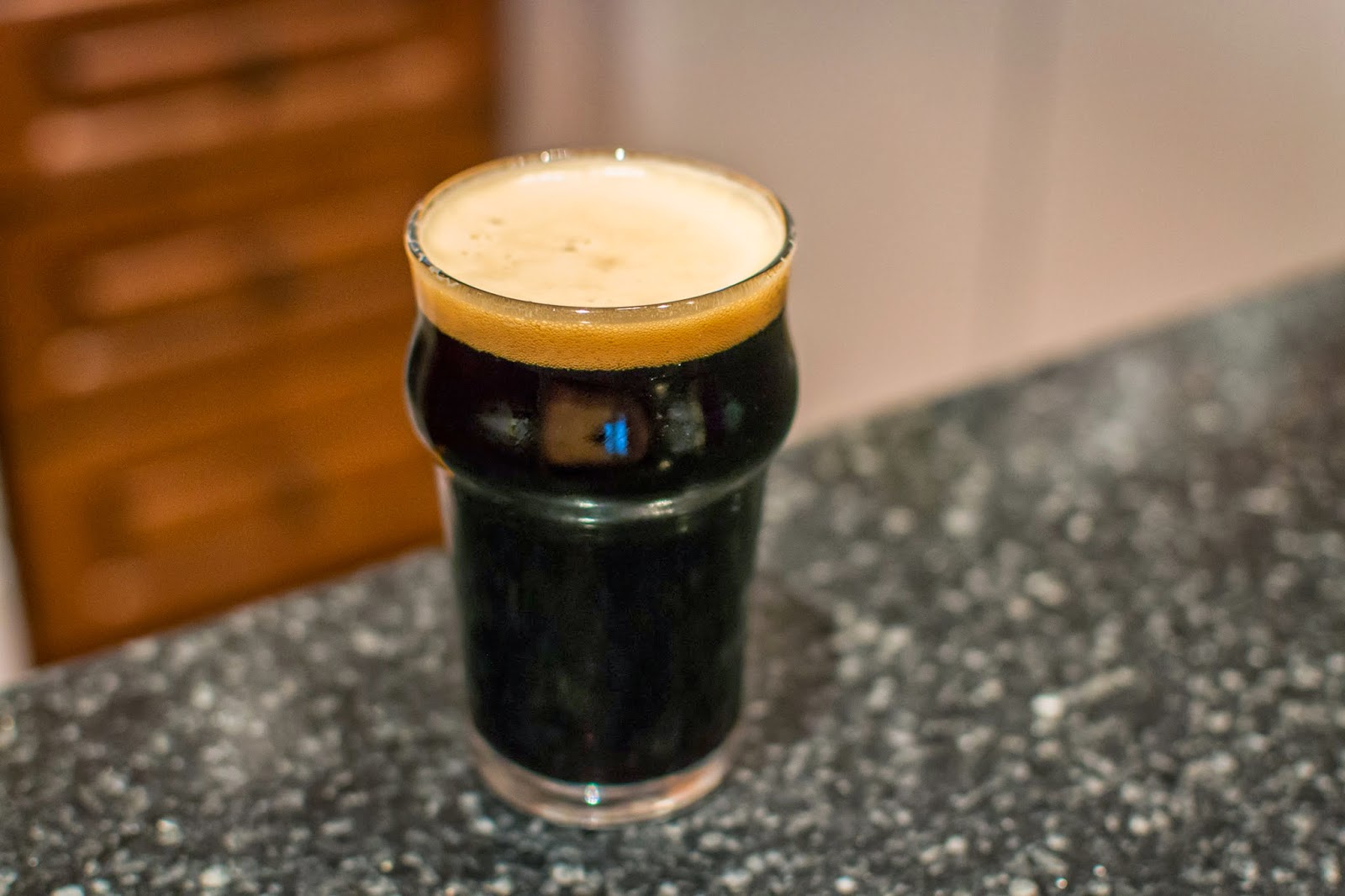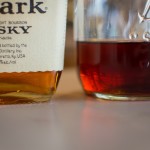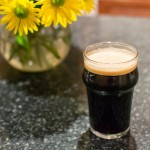Russian Imperial Stout

So, confession time: I’ve never brewed a Russian Imperial Stout. I had planned on brewing one a few years ago, but for whatever reason, I pushed out the brew day. Then for some other reason, I never got around to brewing it. With winter approaching, I figured it was finally time to get around to making a big, massive, roasty stout.
I pieced this recipe together between looking at some of the NHC winning recipes, and looking at my 6-7% ABV stouts that I’ve liked. I added a nice healthy amount of Munich for some maltiness, and spread the roasted grains out between a couple different types. The idea was that Chocolate malt and Carafa would give a more chocolate-like character than Roasted Barley alone. There’s a little Crystal for some sweetness, and I a big healthy dose of Apollo hops to bitter with. In the end, I’d like to think I ended up with a relatively uncomplicated RIS recipe.
Brew day went really well. It was a pretty thick mash, but I didn’t have any issues. I boiled this for 90 minutes, and started to chill it immediately after flameout. I ended up with a shade under 5.5 gallons in the fermenter at 1.102. I hit this with 90 seconds of O2, and pitched a 3-4L starter of WLP090.
Lesson time: Don’t brew a 1.100+ RIS before leaving town for three days. I brewed this on Wednesday night before Thanksgiving. Kristen and I then took off to California to spend Turkey-day with her family. Despite keeping the fermentation temps low and using a blow-off tube….ya…. I came home to a bucket that was on the verge of exploding, and a couple cups of blow off on the bottom of my fridge. Thankfully the lid never blew, and after a little clean-up, everything was fine.
Brewed: 11-27-13
Kegged: 12-07-13
OG: 1.102
FG: 1.022
ABV: 10.5%
IBU: ~70
6 gallons
21.5lbs 2-Row
2lb Munich
10oz Roasted Barley
10oz Chocolate Malt
8oz Carafa III
8oz English Medium Crystal
8oz C120
Mash @ 152
1.75oz Apollo @ 90
.75oz Apollo @ 15
WLP090 – Super San Diego
Fermentation wrapped up after roughly 6-7 days, and I left this in the primary for another few days to finish up before racking it in a keg to rest in. It spent another 2 weeks in a keg before I finally dropped it in the kegerator to carbonate.
So I actually still have this beer on tap, and I have to say, it turned out really, really nice. It was very good after a couple weeks, but it’s excellent now after a few months. The aroma is deep rich roasted malts with lots of chocolate and raisin aromas, and no real hop aroma to note. The appearance is a thick viscous jet-black with a thick tan head. The flavor definitely follows the aroma with a smooth roast character, lots of chocolate flavors, and a full finish. Fermentation character is super clean, which is something I was worried about considering the big blow-off. I wouldn’t call the beer sweet, but rather full, for lack of a better word.
Anyway, ya. This turned out to be a damn good RIS. I’d like to play around with this recipe in the future with some vanilla, chocolate, or coffee, but for now I’m happy to say I have a nice stock RIS recipe.




Learned that same lesson. Left town a few days after brewing a 1.101 RIS last fall for a long Labor Day weekend. Came home to a mess, despite the blowoff tube. Fortunately, the beer was fine, it was just a PITA to clean up. May have to look into adding some Munich malt the next time I brew it.
Scott, is your amount for the base malt correct, 21.5 lbs? i calculated the recipe at 75% mash eff and that gets 1.118 for an OG. did you not get a great efficiency with this one?
You probably need to lower your efficiency quite a bit, a beer that high you're probably looking at 65%.
Scott, I've been waiting for this post! Care to compare your beer to a commercial example?
–Chris
Your recipe looks really good. I recently broke into a RIS that I left in secondary with B. Lambicus for 7 months, turned out really interesting and tasty. Not incredibly high, clocking in around 8.3% ABV.
My question for you is you mentioned racking the beer into a keg but not carbonating it for some time. Is this sort of your secondary process, or did you not have space in the kegerator for it until a few weeks? Do you do this with all beers? Some beers? Big beers?
Scott, what is your water treatment for a beer like this?
I am curious what your water treatment is as well. Also, I am trying to make a similar beer to Stone Go To IPA their session 4.5% beer. The hops are Mosaic, Citra, Ahtanum, Cascade, Crystal, 06300, El Dorado, Magnum, and Sterling . They say its only hopbursted and no hops before the 15 minute mark according to their blog and youtube video I watched. Any idea what their grain bill might be like for this one? It's a super light crisp beer that is super refreshing.
Thanks
not to speak for scott but i wouldn't be surprised to see that he follows this:
http://www.homebrewtalk.com/f128/brewing-water-chemistry-primer-198460/
Scott has written about water treatment before https://www.bertusbrewery.com/2012/02/water-chemistry-how-to-build-your-water.html
Where he references that thread
Hope you're well, looking forward to an update!
Ya, you wouldn't think a RIS needs more malt character, but it definitely adds something nice.
Yup, my efficiency drops pretty sharply over 1.080 (no water to sparge with).
Brew enough batches without changing any equipment, and I'd be surprised if you don't notice a drop in efficiency as well once the OG starts building over 1.060. I get:
Under 1.050: 82-84
1.050-1.065: 75-80
1.065-1.080: 72-75
1.080: It falls off fast. 68%? maybe less?
A little less bitter version of narwhal I would say.
I don't have any smaller fermenters than 6.5gal, so I treat corny kegs as secondaries. In my mind they're better. They're: Stainless, easy to clean, and they hold pressure. If there happens to be any fermentation left, it helps carb the beer, and once I'm happy aging it for whatever length of time, I can just toss it i the kegerator.
I don't do this with all beers, just big beers I want to age a bit (and IPAs for dry hopping, but that's another story).
I just RO water, but I hardened it up quite a bit for this beer. I think it was like 1tsp calcium chloride and 1.5, maybe 2 tsp of gypsum. I don't use any acid malt for beers with a decent amount of roasted malt.
Brewed this about a month ago and after primary, I split it into two-2.5 gallon kegs. Half got 800ml of concentrated cold brew, the other half got .75oz of med+ american oak. The Cold brew half has been in the keezer for about 3 weeks now and is already one of the best RIS's I've had. The oaked half has been at room temp on the oak for about two weeks and I'm just tasting it once a week until it seems right, initial tastes are very promising though.
Hello Scott,
how was your process of maceration? Roasted malt added to the end of mash? Any recommendation? sorry my english.
[…] aging process, as I covered that in my last post.For this recipe, I borrowed heavily from my prior Imperial Stout. I felt that beer turned out really nicely, so I wanted to carry over as much as I could. The main […]